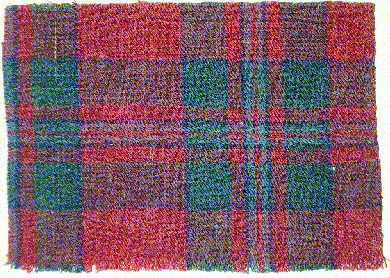
Home
Design
Consultancy
TARTAN HISTORY Research
BUY TARTAN Links
Report
on an Unidentified 18th Century Specimen
In Nov 2004 I was loaned an old piece of
‘Hard Tartan’ for comment. The present
owner know little is known of its origins, he has had the specimen for a
long time having been given it by a colleague many years earlier. This
colleague is thought to have obtained the sample in Edinburgh. This may
throw some light on the earlier ownership of the sample which is examined below.
The specimen is mounted on a piece of fine card on which ‘Old Sett’ and ‘84’ are written in pencil. The elegant looped hand writing is of a style that was common before about 1930 which, together with the number, suggests that the piece may have been part of a collection compiled at some point prior to that date: possibly that of Alexander Carmicheal or John Telfer Dunbar. Examination of the piece, and dye analysis of other examples of a similar antiquity, suggests that the dyestuffs used in this sample were cochineal (red) and indigo (blues) plus an unknown yellow source used in combination with indigo for the green. The sample is in twill weave @ 40 epi using singles in both warp and weft; it measures roughly 22 x 15 cms with one of the shorter edges (right below) being a selvedge.
The threadcount is: R/2 LB6 B4 R12 G36 B4 R/46 – half sett, half pivot count

A number of similar counts for different samples have been recorded over the years; for example and comparison,
R/2 LB6 B4 R12 G36 B4 R/46 - sample (above) loaned to the writer.
R/2 LB6 B4 R12 G36 LB4 R/46 - count from the Mss version of the Smith Bros' 1850 work Authenticated Tartans of the Clans and Families of Scotland.
R/2 LB6 B4 R16 G48 N4
R/60 - scale by James McKinlay from a sample in the Marquis of Bute's
Collection.
There is clearly a very close resemblance between all three of these tartans, so much so in fact, that one has to question whether the latter two were actually mal-recordings of the former. However, the fact that both record the stripe at the edge of the large red as being LB (light blue) or N (gray) and, if one accepts that the N (not a traditional colour) was probably a mistake for LB, I'm forced to conclude that they may have in fact recorded a different piece of what is basically the same tartan but for the shade of blue bordering the large red square. The fact that count for McKinlay's sample has slightly different proportions is explained by the fact that he did not count the threads but measured the stripes and squares and multiplied by 4 to give the number of threads. It is possible that he measured the third sample accurately, but equally possible that he made a measuring/calculation error. Presumably the sample that he measures is extant and still in the Bute Collection in which case it would simply be a matter of checking it to confirm the threadcount. Unfortunately the collection is at Mount Stuart on Rothesay and so is not immediately accessible. Regrettably there is no information on the current whereabouts of the sample that the Smiths recorded in their Mss.
To conclude, this is a fine example of a piece of 18th century tartan that shows similarities to the MacIntosh tartan, itself know to date to the mid-18th century at least. It is virtually impossible to ascertain anything more about its origins but there are/were one or two similar pieces in existence during the 19th and 20th centuries. Many of the Bute samples were collected from the west coast and islands and it may be that this design originated from there. Unfortunately we will probably never know.
© Peter MacDonald 2005